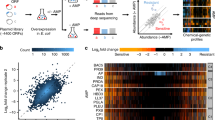Abstract
Small cationic peptides with antibiotic properties have been isolated from a diverse array of evolutionarily divergent organisms, including insects, amphibians, mammals, and plants. They contribute to the innate immunity of the host by fending off opportunistic (i.e., environmental) microorganisms. Moreover, antimicrobial peptides present a chemical barrier early in infection before the mammalian host induces the specific type of immune response constituted by antibodies and T cells (1,2). Microorganisms have coexisted with their animal hosts for millions of years and have, in turn, evolved strategies that enable them to avoid or withstand the various microbicidal activities of the host (3). For example, the mammalian pathogen Salmonella typhimurium has several genes that confer resistance to host defense peptides, presumably allowing it to successfully colonize host tissues that are rich in antimicrobial peptides. The demonstration that mutants of S. typhimurium that are hypersusceptible to the killing effects of host-defense peptides are attenuated for virulence in mice has established that resistance to small cationic peptides is a virulence property of Salmonella (4) and, potentially, of other enteric pathogens.
Access this chapter
Tax calculation will be finalised at checkout
Purchases are for personal use only
Similar content being viewed by others
References
Zasloff, M. (1992) Antibiotic peptides as mediators of innate immunity. Curr Opin. Immunol. 4, 3–7.
Boman, H. G. (1995) Peptide antibiotics and their role in innate immunity. Annu Rev. Immunol. 13, 61–92.
Groisman, E. A. (1994) How bacteria resist killing by host-defense peptides. Trends Microbiol. 2, 444–449.
Grossman, E. A., Parra, C. A., Salcedo, M., Lipps, C. J., and Heffron, F. (1992) Resistance to host antimicrobial peptides is necessary for Salmonella virulence. Proc. Natl. Acad Sci. USA. 89, 11,939–11,943.
Christensen, B., Fink, J., Merrifield, R. B., and Mauzerall, D. (1988) Channel-forming properties of cecropins and related model compounds incorporated into planar lipid membranes. Proc. Natl. Acad Sci. USA 85, 5072–5076.
Kagan, B. L., Selsted, M. E., Ganz, T., and Lehrer, R. I. (1990) Antimicrobial defensin peptides form voltage-dependent ion-permeable channels in planar lipid bilayer membranes. Proc. Natl. Acad. Sci. USA 87, 210–214.
Cruciani, R. A., Barker, J. L., Zasloff, M., Chen, H. C., and Colamonici, O. (1991). Antibiotic magainins exert cytolytic activity against transformed cell lines trough channel formation. Proc. Natl. Acad. Sci. USA 88, 3792–3796.
Cociancich, S., Ghazi, A., Hetru, C., Hoffmann, J. A., and Letelher, L. (1993) Insect defensin, an inducible antibacterial peptide forms votage-dependent channels in MIcrococcus luteus J. Biol. Chem. 268, 19,239–19,245.
Lehrer, R. I., Barton, A., Daher, K. A., Harwig, S. S., Ganz, T., and Selsted, M. E. (1989) Interaction of human defensins with Escherichia coli, Mechanism of bactericidal activity J. Clin. Invest. 84, 553–61.
Garcia Véscovi, E., Soncini, F. C., and Groisman, E. A. (1996) Mg2+ as an extracellular signal: environmental regulation of Salmonella virulence Cell 84, 165–174.
Leyer, G. J., and Johnson, E. A. (1993) Acid adaptation induces cross-protection against environmental stresses in Salmonella typhimurium Appl. Environ. Microbiol. 59, 1842–1847.
Foster, J. W., and Spector, M. P. (1995) How Salmonella survive against the odds Annu. Rev. Microbiol. 49, 145–174.
Miller, J. H., ed. (1991) Bacterial Genetic Systems Methods in Enzymology Academic, San Diego.
Mäkela, P. H., Sarvas, M., Calagno, S., and Lounatmaa, K. (1978) Isolation and characterization of polymyxin-resistant mutants of Salmonella FEMS Microbiol 3, 323–326.
Roland, K. L., Martin, L. E., Esther, C. R., and Spitznagel, J. K. (1993) Spontaneous pmrA mutants of Salmonella typhimurium LT2 define a new-two-component regulatory system with a possible role in virulence. J. Bacteriol. 175,4154–4164.
Roland, K. L., Esther, C. R., and Spitznagel, J. K. (1994) Isolation and characterization of a gene, pmrD, from Salmonella typhimurium that confers resistance to polymyxin when expressed in multiple copies J. Bacteriol. 176, 3589–3597.
Parra-Lopez, C., Baer, M. T., and Groisman, E. A. (1993) Molecular genetic analysis of a locus required for resistance to antimicrobial peptides in Salmonella typhimurium. EMBO. J. 12, 4053–4062.
Parra-Lopez, C., Lin, R., Aspedon, A., and Groisman, E. A. (1994) A Salmonella protein that is required for resistance to antimicrobial peptides and transport of potassium EMBO J 13, 3964–3972.
Author information
Authors and Affiliations
Editor information
Editors and Affiliations
Rights and permissions
Copyright information
© 1997 Humana Press Inc.
About this protocol
Cite this protocol
Groisman, E.A., Aspedon, A. (1997). The Genetic Basis of Microbial Resistance to Antimicrobial Peptides. In: Shafer, W.M. (eds) Antibacterial Peptide Protocols. Methods In Molecular Biology™, vol 78. Humana Press. https://doi.org/10.1385/0-89603-408-9:205
Download citation
DOI: https://doi.org/10.1385/0-89603-408-9:205
Publisher Name: Humana Press
Print ISBN: 978-0-89603-408-2
Online ISBN: 978-1-59259-564-8
eBook Packages: Springer Protocols




